International Trade Across Borders: Pakistan's Economic Overview
VerifiedAdded on 2020/04/01
|12
|2992
|32
Report
AI Summary
This report provides a comprehensive overview of international trade in Pakistan. It begins with a general overview of Pakistan, its population, currency, and core economic activities. The report then delves into the political, economic, social-cultural, and technological influences on Pakistan's trade, including the impact of political instability, economic growth, cultural factors, and technological advancements. It also examines the country's natural resources and their role in trade, along with the effects of foreign currency and exchange rates on imports and exports. The report analyzes Pakistan's existing trade policies, systems, barriers, and incentives, including annual trade policies, trade barriers such as political instability and lack of infrastructure, and incentives such as tax reductions and reduced exchange rates. Furthermore, it discusses the existing levels of Foreign Direct Investment (FDI) in Pakistan, differentiating between inward and outward investment. Finally, the report offers recommendations and concludes with a summary of the key findings and implications for Pakistan's international trade performance and future economic development.
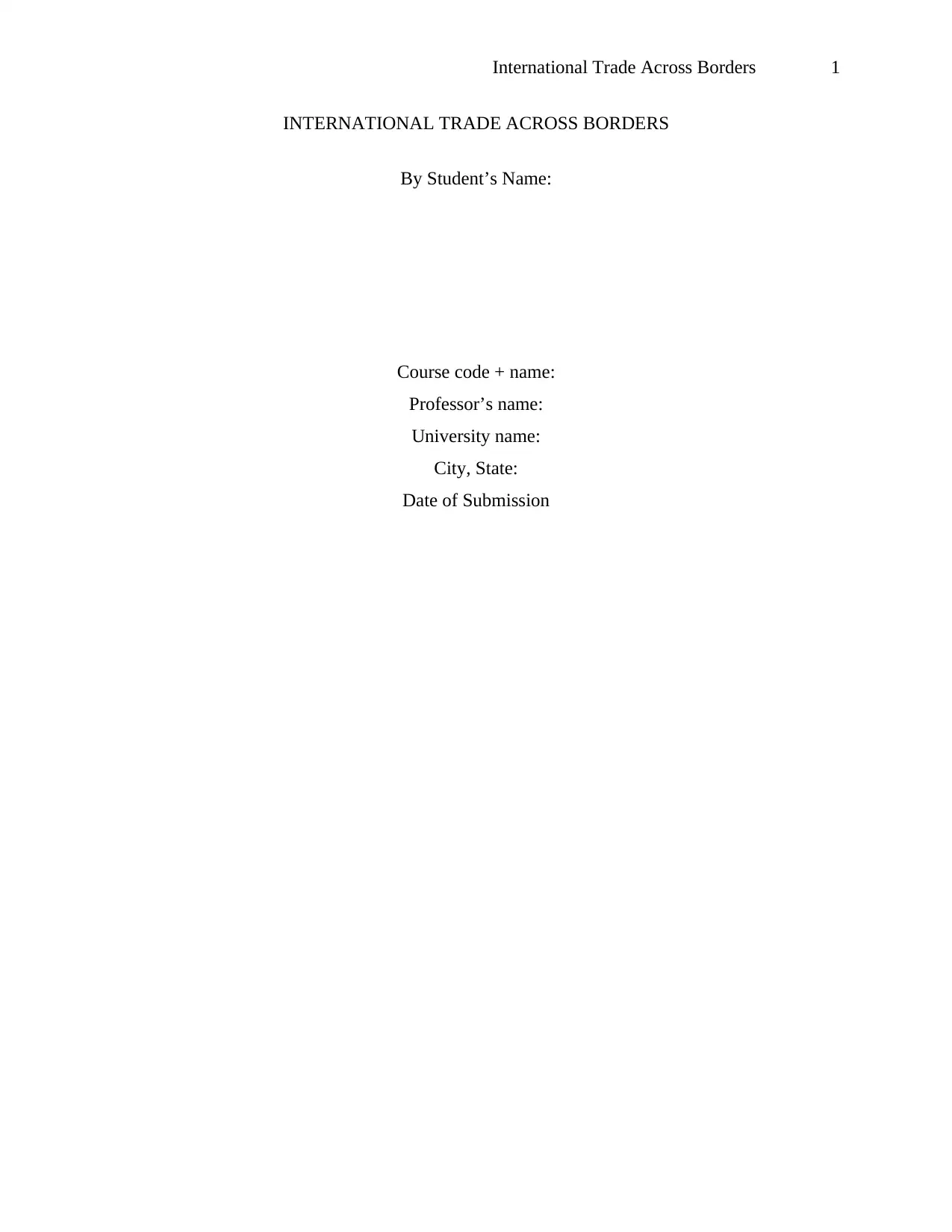
International Trade Across Borders 1
INTERNATIONAL TRADE ACROSS BORDERS
By Student’s Name:
Course code + name:
Professor’s name:
University name:
City, State:
Date of Submission
INTERNATIONAL TRADE ACROSS BORDERS
By Student’s Name:
Course code + name:
Professor’s name:
University name:
City, State:
Date of Submission
Paraphrase This Document
Need a fresh take? Get an instant paraphrase of this document with our AI Paraphraser
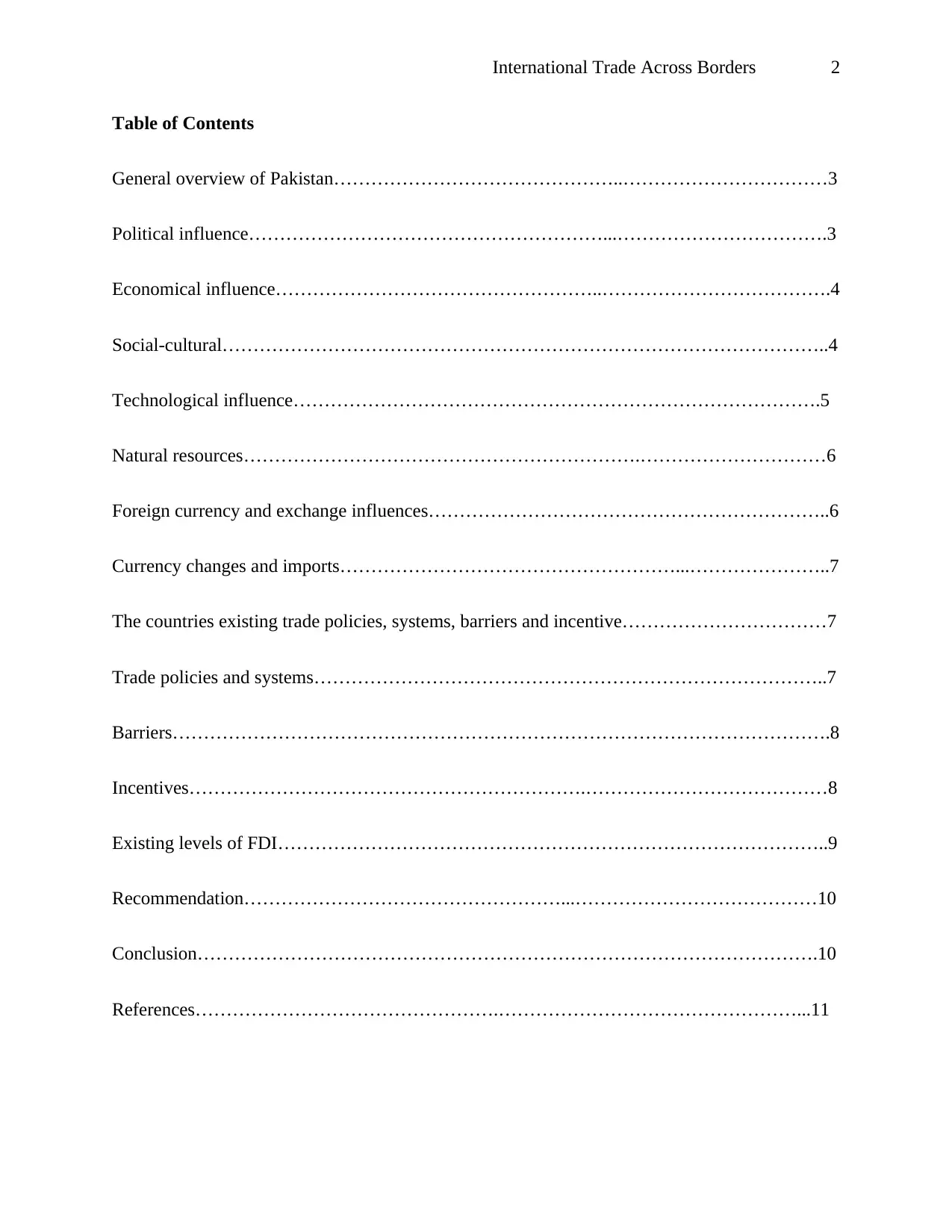
International Trade Across Borders 2
Table of Contents
General overview of Pakistan………………………………………..……………………………3
Political influence…………………………………………………...…………………………….3
Economical influence……………………………………………..……………………………….4
Social-cultural……………………………………………………………………………………..4
Technological influence………………………………………………………………………….5
Natural resources……………………………………………………….…………………………6
Foreign currency and exchange influences………………………………………………………..6
Currency changes and imports………………………………………………...…………………..7
The countries existing trade policies, systems, barriers and incentive……………………………7
Trade policies and systems………………………………………………………………………..7
Barriers…………………………………………………………………………………………….8
Incentives……………………………………………………….…………………………………8
Existing levels of FDI……………………………………………………………………………..9
Recommendation……………………………………………...…………………………………10
Conclusion……………………………………………………………………………………….10
References………………………………………….…………………………………………...11
Table of Contents
General overview of Pakistan………………………………………..……………………………3
Political influence…………………………………………………...…………………………….3
Economical influence……………………………………………..……………………………….4
Social-cultural……………………………………………………………………………………..4
Technological influence………………………………………………………………………….5
Natural resources……………………………………………………….…………………………6
Foreign currency and exchange influences………………………………………………………..6
Currency changes and imports………………………………………………...…………………..7
The countries existing trade policies, systems, barriers and incentive……………………………7
Trade policies and systems………………………………………………………………………..7
Barriers…………………………………………………………………………………………….8
Incentives……………………………………………………….…………………………………8
Existing levels of FDI……………………………………………………………………………..9
Recommendation……………………………………………...…………………………………10
Conclusion……………………………………………………………………………………….10
References………………………………………….…………………………………………...11
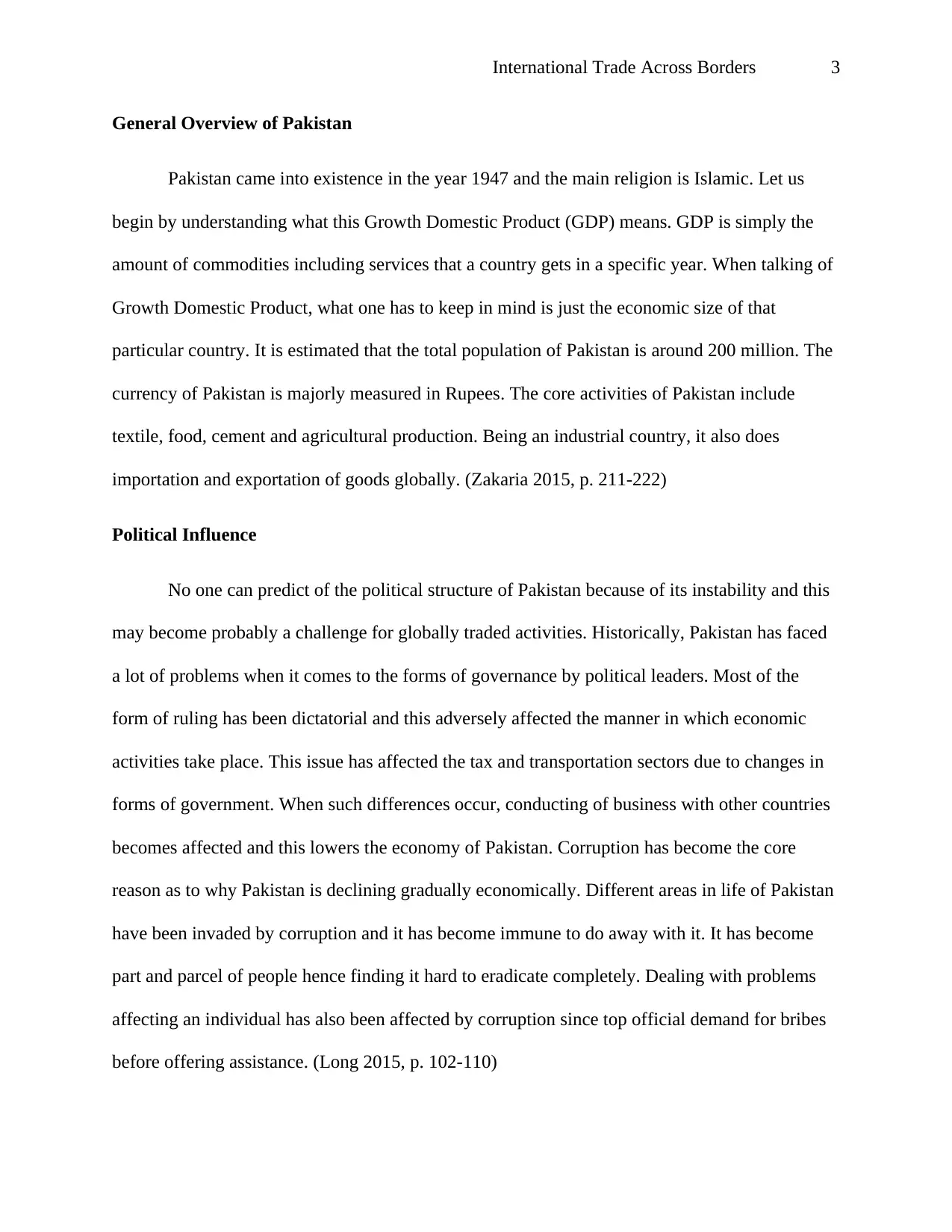
International Trade Across Borders 3
General Overview of Pakistan
Pakistan came into existence in the year 1947 and the main religion is Islamic. Let us
begin by understanding what this Growth Domestic Product (GDP) means. GDP is simply the
amount of commodities including services that a country gets in a specific year. When talking of
Growth Domestic Product, what one has to keep in mind is just the economic size of that
particular country. It is estimated that the total population of Pakistan is around 200 million. The
currency of Pakistan is majorly measured in Rupees. The core activities of Pakistan include
textile, food, cement and agricultural production. Being an industrial country, it also does
importation and exportation of goods globally. (Zakaria 2015, p. 211-222)
Political Influence
No one can predict of the political structure of Pakistan because of its instability and this
may become probably a challenge for globally traded activities. Historically, Pakistan has faced
a lot of problems when it comes to the forms of governance by political leaders. Most of the
form of ruling has been dictatorial and this adversely affected the manner in which economic
activities take place. This issue has affected the tax and transportation sectors due to changes in
forms of government. When such differences occur, conducting of business with other countries
becomes affected and this lowers the economy of Pakistan. Corruption has become the core
reason as to why Pakistan is declining gradually economically. Different areas in life of Pakistan
have been invaded by corruption and it has become immune to do away with it. It has become
part and parcel of people hence finding it hard to eradicate completely. Dealing with problems
affecting an individual has also been affected by corruption since top official demand for bribes
before offering assistance. (Long 2015, p. 102-110)
General Overview of Pakistan
Pakistan came into existence in the year 1947 and the main religion is Islamic. Let us
begin by understanding what this Growth Domestic Product (GDP) means. GDP is simply the
amount of commodities including services that a country gets in a specific year. When talking of
Growth Domestic Product, what one has to keep in mind is just the economic size of that
particular country. It is estimated that the total population of Pakistan is around 200 million. The
currency of Pakistan is majorly measured in Rupees. The core activities of Pakistan include
textile, food, cement and agricultural production. Being an industrial country, it also does
importation and exportation of goods globally. (Zakaria 2015, p. 211-222)
Political Influence
No one can predict of the political structure of Pakistan because of its instability and this
may become probably a challenge for globally traded activities. Historically, Pakistan has faced
a lot of problems when it comes to the forms of governance by political leaders. Most of the
form of ruling has been dictatorial and this adversely affected the manner in which economic
activities take place. This issue has affected the tax and transportation sectors due to changes in
forms of government. When such differences occur, conducting of business with other countries
becomes affected and this lowers the economy of Pakistan. Corruption has become the core
reason as to why Pakistan is declining gradually economically. Different areas in life of Pakistan
have been invaded by corruption and it has become immune to do away with it. It has become
part and parcel of people hence finding it hard to eradicate completely. Dealing with problems
affecting an individual has also been affected by corruption since top official demand for bribes
before offering assistance. (Long 2015, p. 102-110)
⊘ This is a preview!⊘
Do you want full access?
Subscribe today to unlock all pages.

Trusted by 1+ million students worldwide
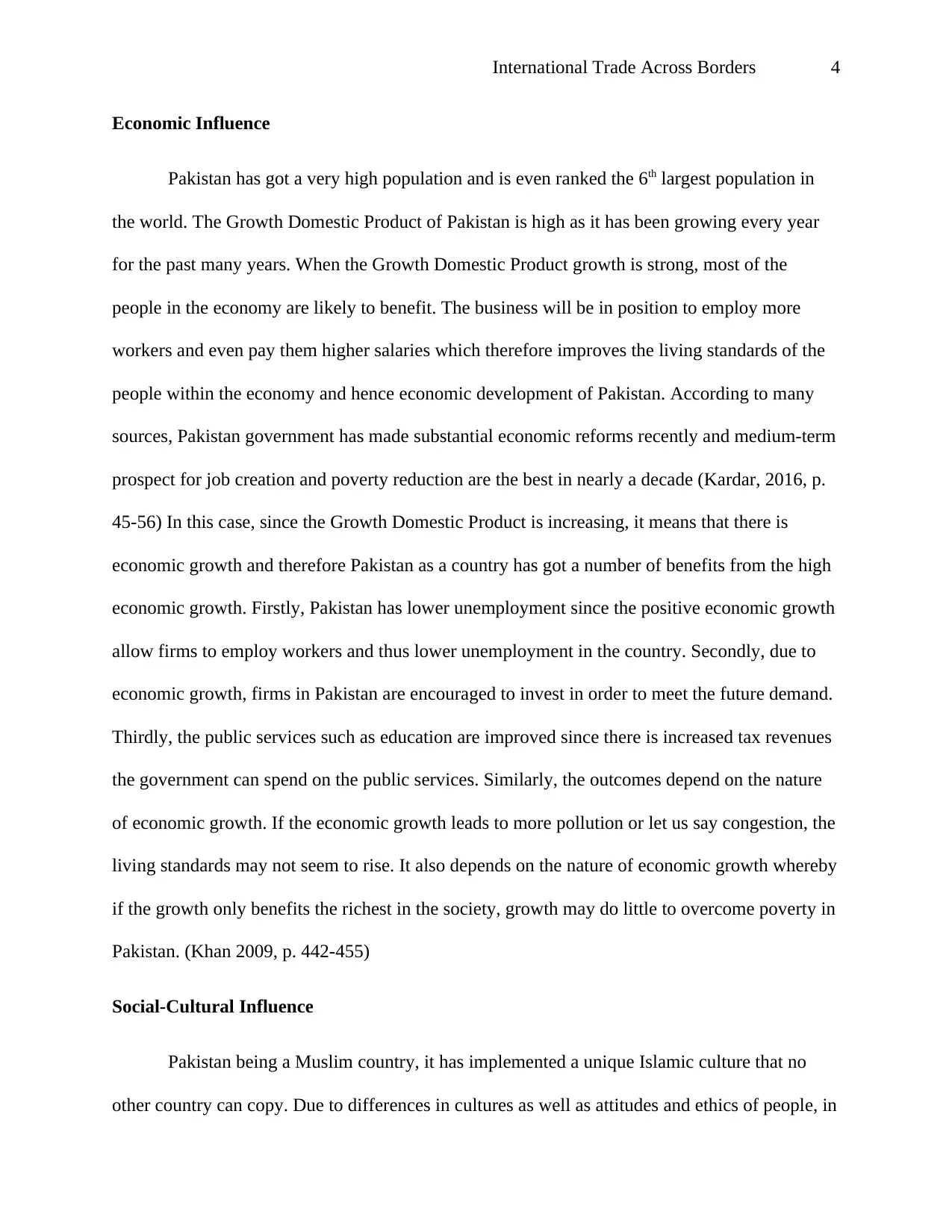
International Trade Across Borders 4
Economic Influence
Pakistan has got a very high population and is even ranked the 6th largest population in
the world. The Growth Domestic Product of Pakistan is high as it has been growing every year
for the past many years. When the Growth Domestic Product growth is strong, most of the
people in the economy are likely to benefit. The business will be in position to employ more
workers and even pay them higher salaries which therefore improves the living standards of the
people within the economy and hence economic development of Pakistan. According to many
sources, Pakistan government has made substantial economic reforms recently and medium-term
prospect for job creation and poverty reduction are the best in nearly a decade (Kardar, 2016, p.
45-56) In this case, since the Growth Domestic Product is increasing, it means that there is
economic growth and therefore Pakistan as a country has got a number of benefits from the high
economic growth. Firstly, Pakistan has lower unemployment since the positive economic growth
allow firms to employ workers and thus lower unemployment in the country. Secondly, due to
economic growth, firms in Pakistan are encouraged to invest in order to meet the future demand.
Thirdly, the public services such as education are improved since there is increased tax revenues
the government can spend on the public services. Similarly, the outcomes depend on the nature
of economic growth. If the economic growth leads to more pollution or let us say congestion, the
living standards may not seem to rise. It also depends on the nature of economic growth whereby
if the growth only benefits the richest in the society, growth may do little to overcome poverty in
Pakistan. (Khan 2009, p. 442-455)
Social-Cultural Influence
Pakistan being a Muslim country, it has implemented a unique Islamic culture that no
other country can copy. Due to differences in cultures as well as attitudes and ethics of people, in
Economic Influence
Pakistan has got a very high population and is even ranked the 6th largest population in
the world. The Growth Domestic Product of Pakistan is high as it has been growing every year
for the past many years. When the Growth Domestic Product growth is strong, most of the
people in the economy are likely to benefit. The business will be in position to employ more
workers and even pay them higher salaries which therefore improves the living standards of the
people within the economy and hence economic development of Pakistan. According to many
sources, Pakistan government has made substantial economic reforms recently and medium-term
prospect for job creation and poverty reduction are the best in nearly a decade (Kardar, 2016, p.
45-56) In this case, since the Growth Domestic Product is increasing, it means that there is
economic growth and therefore Pakistan as a country has got a number of benefits from the high
economic growth. Firstly, Pakistan has lower unemployment since the positive economic growth
allow firms to employ workers and thus lower unemployment in the country. Secondly, due to
economic growth, firms in Pakistan are encouraged to invest in order to meet the future demand.
Thirdly, the public services such as education are improved since there is increased tax revenues
the government can spend on the public services. Similarly, the outcomes depend on the nature
of economic growth. If the economic growth leads to more pollution or let us say congestion, the
living standards may not seem to rise. It also depends on the nature of economic growth whereby
if the growth only benefits the richest in the society, growth may do little to overcome poverty in
Pakistan. (Khan 2009, p. 442-455)
Social-Cultural Influence
Pakistan being a Muslim country, it has implemented a unique Islamic culture that no
other country can copy. Due to differences in cultures as well as attitudes and ethics of people, in
Paraphrase This Document
Need a fresh take? Get an instant paraphrase of this document with our AI Paraphraser
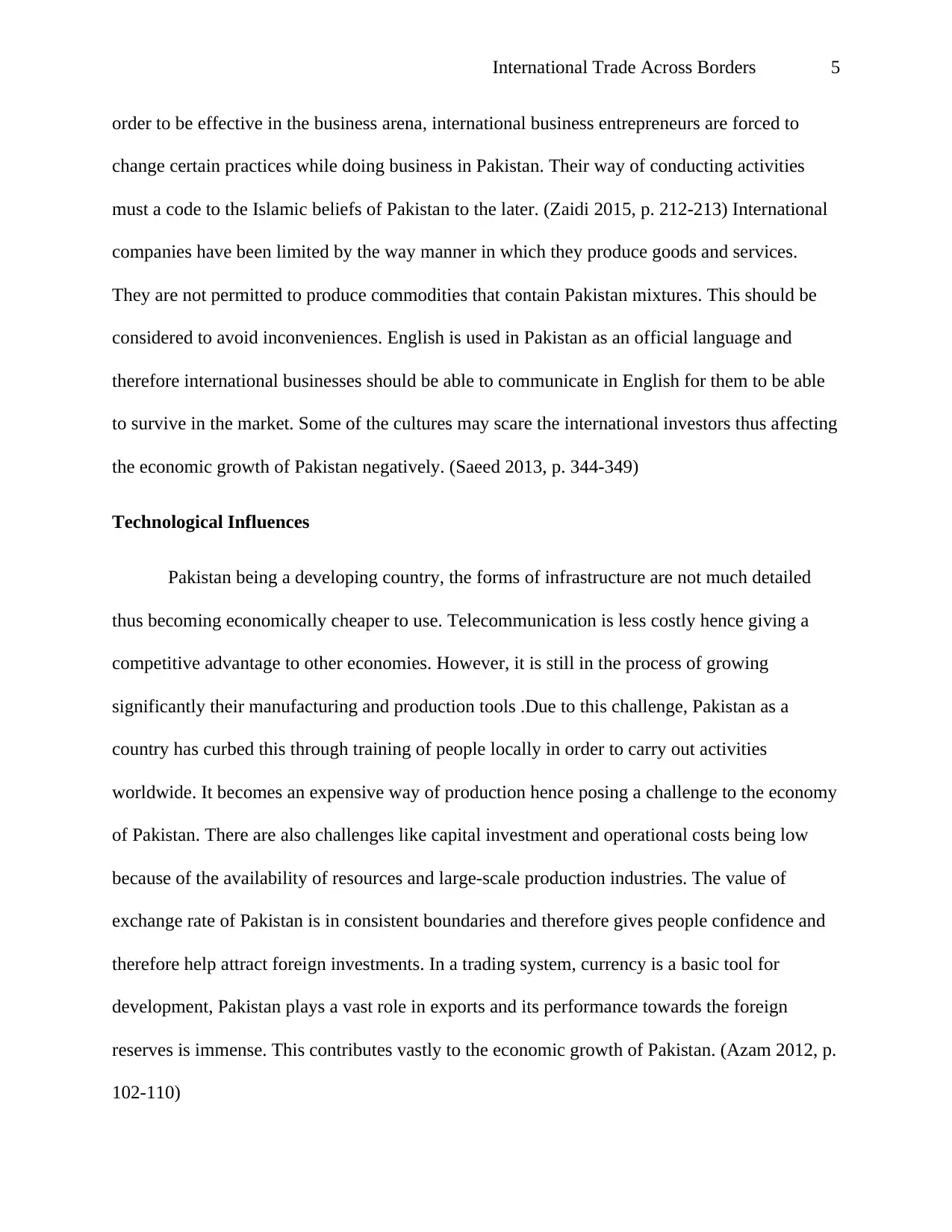
International Trade Across Borders 5
order to be effective in the business arena, international business entrepreneurs are forced to
change certain practices while doing business in Pakistan. Their way of conducting activities
must a code to the Islamic beliefs of Pakistan to the later. (Zaidi 2015, p. 212-213) International
companies have been limited by the way manner in which they produce goods and services.
They are not permitted to produce commodities that contain Pakistan mixtures. This should be
considered to avoid inconveniences. English is used in Pakistan as an official language and
therefore international businesses should be able to communicate in English for them to be able
to survive in the market. Some of the cultures may scare the international investors thus affecting
the economic growth of Pakistan negatively. (Saeed 2013, p. 344-349)
Technological Influences
Pakistan being a developing country, the forms of infrastructure are not much detailed
thus becoming economically cheaper to use. Telecommunication is less costly hence giving a
competitive advantage to other economies. However, it is still in the process of growing
significantly their manufacturing and production tools .Due to this challenge, Pakistan as a
country has curbed this through training of people locally in order to carry out activities
worldwide. It becomes an expensive way of production hence posing a challenge to the economy
of Pakistan. There are also challenges like capital investment and operational costs being low
because of the availability of resources and large-scale production industries. The value of
exchange rate of Pakistan is in consistent boundaries and therefore gives people confidence and
therefore help attract foreign investments. In a trading system, currency is a basic tool for
development, Pakistan plays a vast role in exports and its performance towards the foreign
reserves is immense. This contributes vastly to the economic growth of Pakistan. (Azam 2012, p.
102-110)
order to be effective in the business arena, international business entrepreneurs are forced to
change certain practices while doing business in Pakistan. Their way of conducting activities
must a code to the Islamic beliefs of Pakistan to the later. (Zaidi 2015, p. 212-213) International
companies have been limited by the way manner in which they produce goods and services.
They are not permitted to produce commodities that contain Pakistan mixtures. This should be
considered to avoid inconveniences. English is used in Pakistan as an official language and
therefore international businesses should be able to communicate in English for them to be able
to survive in the market. Some of the cultures may scare the international investors thus affecting
the economic growth of Pakistan negatively. (Saeed 2013, p. 344-349)
Technological Influences
Pakistan being a developing country, the forms of infrastructure are not much detailed
thus becoming economically cheaper to use. Telecommunication is less costly hence giving a
competitive advantage to other economies. However, it is still in the process of growing
significantly their manufacturing and production tools .Due to this challenge, Pakistan as a
country has curbed this through training of people locally in order to carry out activities
worldwide. It becomes an expensive way of production hence posing a challenge to the economy
of Pakistan. There are also challenges like capital investment and operational costs being low
because of the availability of resources and large-scale production industries. The value of
exchange rate of Pakistan is in consistent boundaries and therefore gives people confidence and
therefore help attract foreign investments. In a trading system, currency is a basic tool for
development, Pakistan plays a vast role in exports and its performance towards the foreign
reserves is immense. This contributes vastly to the economic growth of Pakistan. (Azam 2012, p.
102-110)
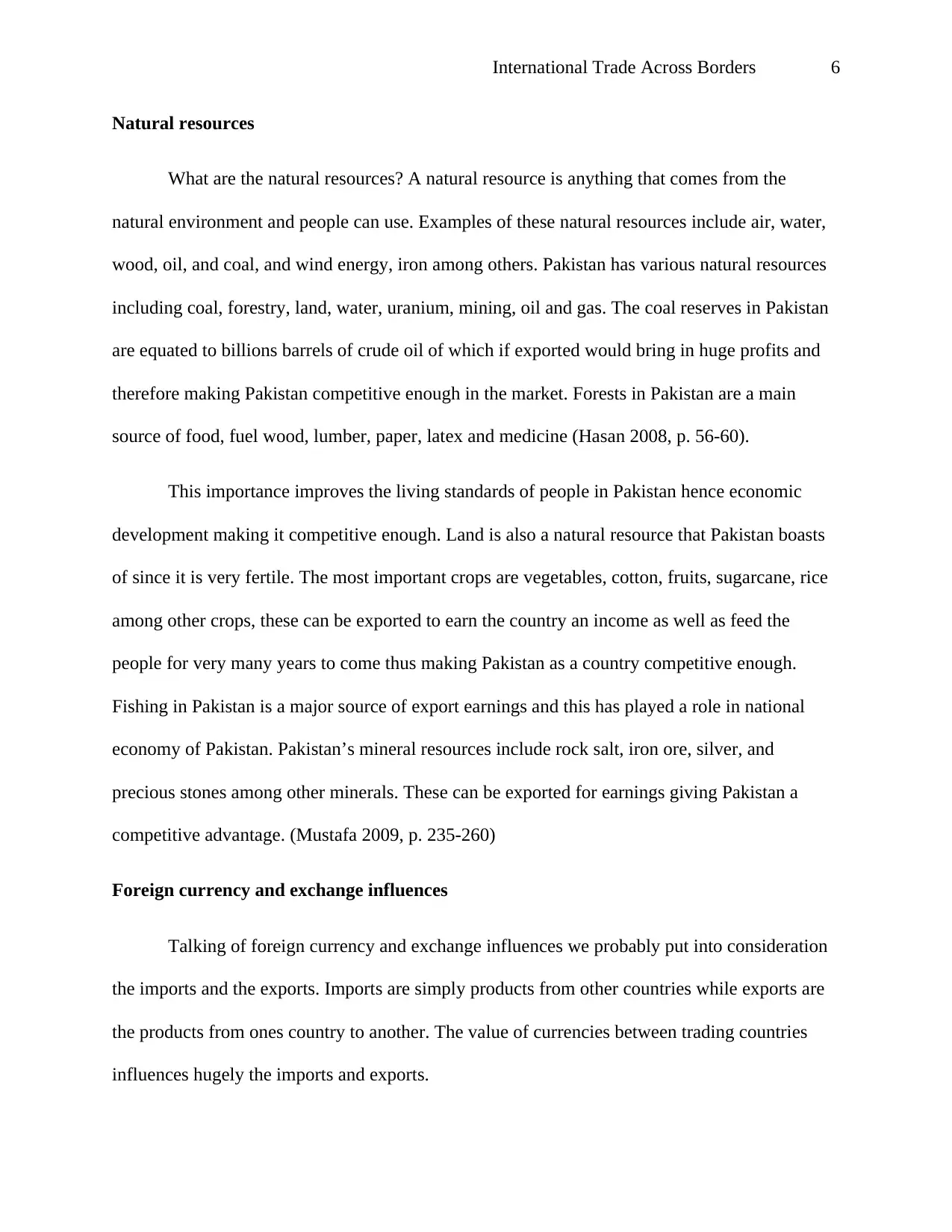
International Trade Across Borders 6
Natural resources
What are the natural resources? A natural resource is anything that comes from the
natural environment and people can use. Examples of these natural resources include air, water,
wood, oil, and coal, and wind energy, iron among others. Pakistan has various natural resources
including coal, forestry, land, water, uranium, mining, oil and gas. The coal reserves in Pakistan
are equated to billions barrels of crude oil of which if exported would bring in huge profits and
therefore making Pakistan competitive enough in the market. Forests in Pakistan are a main
source of food, fuel wood, lumber, paper, latex and medicine (Hasan 2008, p. 56-60).
This importance improves the living standards of people in Pakistan hence economic
development making it competitive enough. Land is also a natural resource that Pakistan boasts
of since it is very fertile. The most important crops are vegetables, cotton, fruits, sugarcane, rice
among other crops, these can be exported to earn the country an income as well as feed the
people for very many years to come thus making Pakistan as a country competitive enough.
Fishing in Pakistan is a major source of export earnings and this has played a role in national
economy of Pakistan. Pakistan’s mineral resources include rock salt, iron ore, silver, and
precious stones among other minerals. These can be exported for earnings giving Pakistan a
competitive advantage. (Mustafa 2009, p. 235-260)
Foreign currency and exchange influences
Talking of foreign currency and exchange influences we probably put into consideration
the imports and the exports. Imports are simply products from other countries while exports are
the products from ones country to another. The value of currencies between trading countries
influences hugely the imports and exports.
Natural resources
What are the natural resources? A natural resource is anything that comes from the
natural environment and people can use. Examples of these natural resources include air, water,
wood, oil, and coal, and wind energy, iron among others. Pakistan has various natural resources
including coal, forestry, land, water, uranium, mining, oil and gas. The coal reserves in Pakistan
are equated to billions barrels of crude oil of which if exported would bring in huge profits and
therefore making Pakistan competitive enough in the market. Forests in Pakistan are a main
source of food, fuel wood, lumber, paper, latex and medicine (Hasan 2008, p. 56-60).
This importance improves the living standards of people in Pakistan hence economic
development making it competitive enough. Land is also a natural resource that Pakistan boasts
of since it is very fertile. The most important crops are vegetables, cotton, fruits, sugarcane, rice
among other crops, these can be exported to earn the country an income as well as feed the
people for very many years to come thus making Pakistan as a country competitive enough.
Fishing in Pakistan is a major source of export earnings and this has played a role in national
economy of Pakistan. Pakistan’s mineral resources include rock salt, iron ore, silver, and
precious stones among other minerals. These can be exported for earnings giving Pakistan a
competitive advantage. (Mustafa 2009, p. 235-260)
Foreign currency and exchange influences
Talking of foreign currency and exchange influences we probably put into consideration
the imports and the exports. Imports are simply products from other countries while exports are
the products from ones country to another. The value of currencies between trading countries
influences hugely the imports and exports.
⊘ This is a preview!⊘
Do you want full access?
Subscribe today to unlock all pages.

Trusted by 1+ million students worldwide
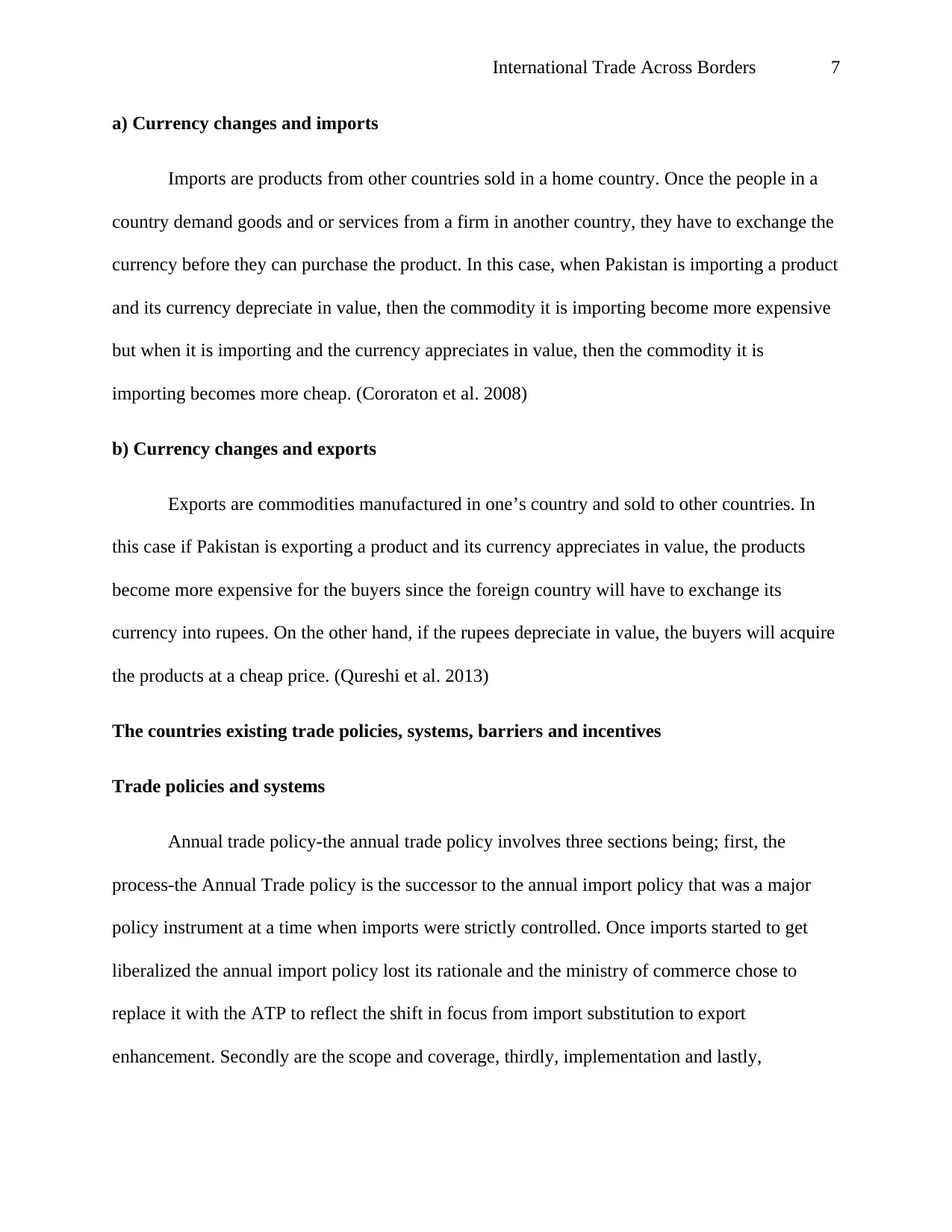
International Trade Across Borders 7
a) Currency changes and imports
Imports are products from other countries sold in a home country. Once the people in a
country demand goods and or services from a firm in another country, they have to exchange the
currency before they can purchase the product. In this case, when Pakistan is importing a product
and its currency depreciate in value, then the commodity it is importing become more expensive
but when it is importing and the currency appreciates in value, then the commodity it is
importing becomes more cheap. (Cororaton et al. 2008)
b) Currency changes and exports
Exports are commodities manufactured in one’s country and sold to other countries. In
this case if Pakistan is exporting a product and its currency appreciates in value, the products
become more expensive for the buyers since the foreign country will have to exchange its
currency into rupees. On the other hand, if the rupees depreciate in value, the buyers will acquire
the products at a cheap price. (Qureshi et al. 2013)
The countries existing trade policies, systems, barriers and incentives
Trade policies and systems
Annual trade policy-the annual trade policy involves three sections being; first, the
process-the Annual Trade policy is the successor to the annual import policy that was a major
policy instrument at a time when imports were strictly controlled. Once imports started to get
liberalized the annual import policy lost its rationale and the ministry of commerce chose to
replace it with the ATP to reflect the shift in focus from import substitution to export
enhancement. Secondly are the scope and coverage, thirdly, implementation and lastly,
a) Currency changes and imports
Imports are products from other countries sold in a home country. Once the people in a
country demand goods and or services from a firm in another country, they have to exchange the
currency before they can purchase the product. In this case, when Pakistan is importing a product
and its currency depreciate in value, then the commodity it is importing become more expensive
but when it is importing and the currency appreciates in value, then the commodity it is
importing becomes more cheap. (Cororaton et al. 2008)
b) Currency changes and exports
Exports are commodities manufactured in one’s country and sold to other countries. In
this case if Pakistan is exporting a product and its currency appreciates in value, the products
become more expensive for the buyers since the foreign country will have to exchange its
currency into rupees. On the other hand, if the rupees depreciate in value, the buyers will acquire
the products at a cheap price. (Qureshi et al. 2013)
The countries existing trade policies, systems, barriers and incentives
Trade policies and systems
Annual trade policy-the annual trade policy involves three sections being; first, the
process-the Annual Trade policy is the successor to the annual import policy that was a major
policy instrument at a time when imports were strictly controlled. Once imports started to get
liberalized the annual import policy lost its rationale and the ministry of commerce chose to
replace it with the ATP to reflect the shift in focus from import substitution to export
enhancement. Secondly are the scope and coverage, thirdly, implementation and lastly,
Paraphrase This Document
Need a fresh take? Get an instant paraphrase of this document with our AI Paraphraser
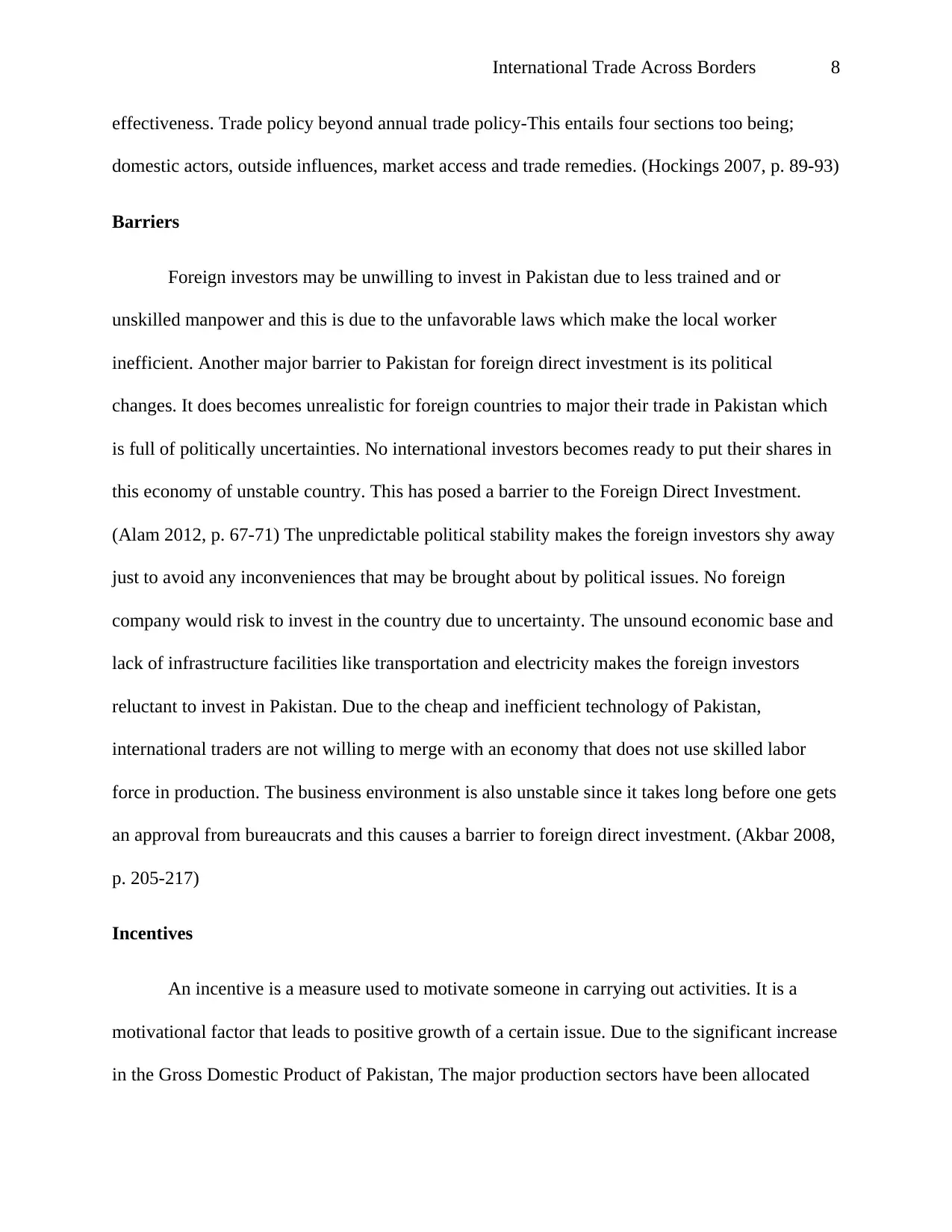
International Trade Across Borders 8
effectiveness. Trade policy beyond annual trade policy-This entails four sections too being;
domestic actors, outside influences, market access and trade remedies. (Hockings 2007, p. 89-93)
Barriers
Foreign investors may be unwilling to invest in Pakistan due to less trained and or
unskilled manpower and this is due to the unfavorable laws which make the local worker
inefficient. Another major barrier to Pakistan for foreign direct investment is its political
changes. It does becomes unrealistic for foreign countries to major their trade in Pakistan which
is full of politically uncertainties. No international investors becomes ready to put their shares in
this economy of unstable country. This has posed a barrier to the Foreign Direct Investment.
(Alam 2012, p. 67-71) The unpredictable political stability makes the foreign investors shy away
just to avoid any inconveniences that may be brought about by political issues. No foreign
company would risk to invest in the country due to uncertainty. The unsound economic base and
lack of infrastructure facilities like transportation and electricity makes the foreign investors
reluctant to invest in Pakistan. Due to the cheap and inefficient technology of Pakistan,
international traders are not willing to merge with an economy that does not use skilled labor
force in production. The business environment is also unstable since it takes long before one gets
an approval from bureaucrats and this causes a barrier to foreign direct investment. (Akbar 2008,
p. 205-217)
Incentives
An incentive is a measure used to motivate someone in carrying out activities. It is a
motivational factor that leads to positive growth of a certain issue. Due to the significant increase
in the Gross Domestic Product of Pakistan, The major production sectors have been allocated
effectiveness. Trade policy beyond annual trade policy-This entails four sections too being;
domestic actors, outside influences, market access and trade remedies. (Hockings 2007, p. 89-93)
Barriers
Foreign investors may be unwilling to invest in Pakistan due to less trained and or
unskilled manpower and this is due to the unfavorable laws which make the local worker
inefficient. Another major barrier to Pakistan for foreign direct investment is its political
changes. It does becomes unrealistic for foreign countries to major their trade in Pakistan which
is full of politically uncertainties. No international investors becomes ready to put their shares in
this economy of unstable country. This has posed a barrier to the Foreign Direct Investment.
(Alam 2012, p. 67-71) The unpredictable political stability makes the foreign investors shy away
just to avoid any inconveniences that may be brought about by political issues. No foreign
company would risk to invest in the country due to uncertainty. The unsound economic base and
lack of infrastructure facilities like transportation and electricity makes the foreign investors
reluctant to invest in Pakistan. Due to the cheap and inefficient technology of Pakistan,
international traders are not willing to merge with an economy that does not use skilled labor
force in production. The business environment is also unstable since it takes long before one gets
an approval from bureaucrats and this causes a barrier to foreign direct investment. (Akbar 2008,
p. 205-217)
Incentives
An incentive is a measure used to motivate someone in carrying out activities. It is a
motivational factor that leads to positive growth of a certain issue. Due to the significant increase
in the Gross Domestic Product of Pakistan, The major production sectors have been allocated
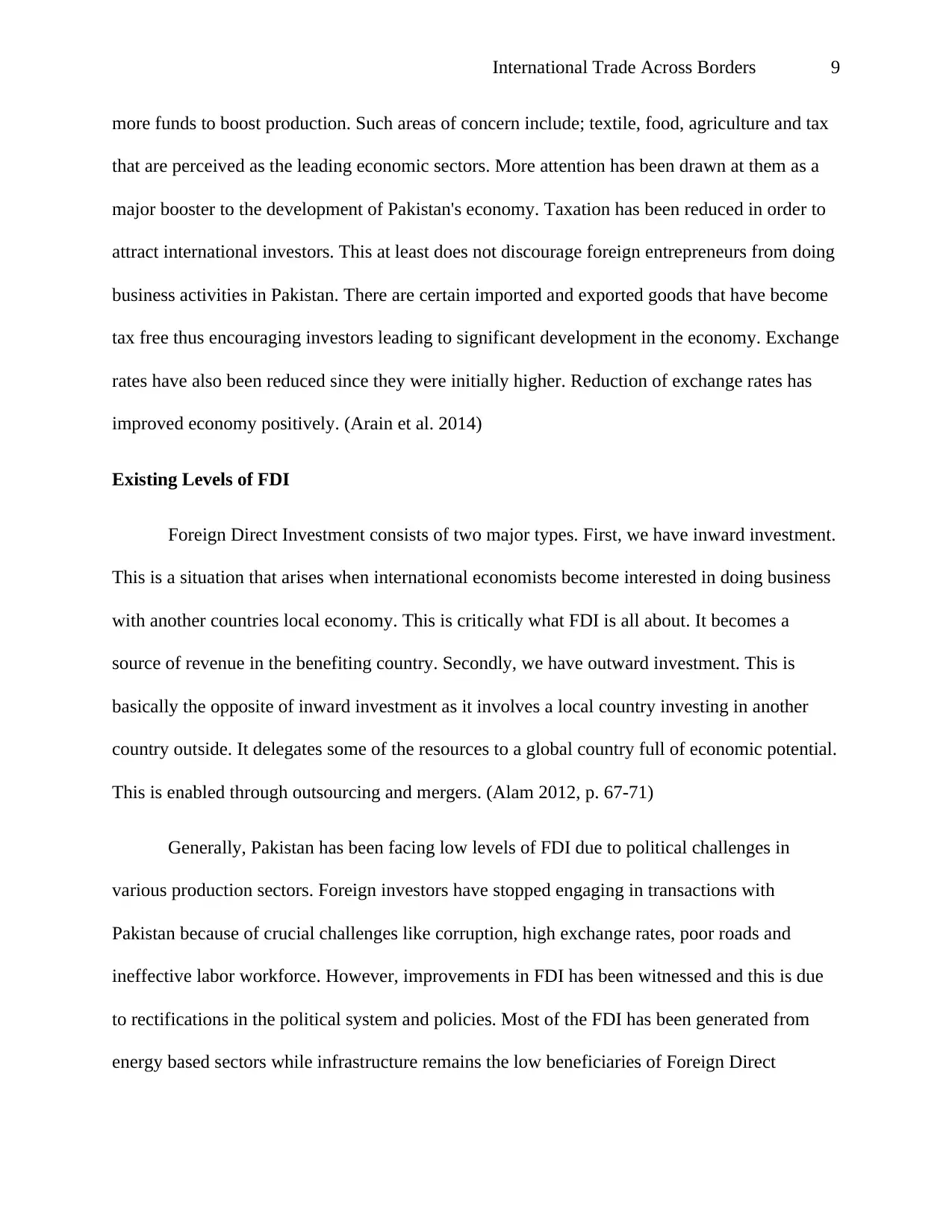
International Trade Across Borders 9
more funds to boost production. Such areas of concern include; textile, food, agriculture and tax
that are perceived as the leading economic sectors. More attention has been drawn at them as a
major booster to the development of Pakistan's economy. Taxation has been reduced in order to
attract international investors. This at least does not discourage foreign entrepreneurs from doing
business activities in Pakistan. There are certain imported and exported goods that have become
tax free thus encouraging investors leading to significant development in the economy. Exchange
rates have also been reduced since they were initially higher. Reduction of exchange rates has
improved economy positively. (Arain et al. 2014)
Existing Levels of FDI
Foreign Direct Investment consists of two major types. First, we have inward investment.
This is a situation that arises when international economists become interested in doing business
with another countries local economy. This is critically what FDI is all about. It becomes a
source of revenue in the benefiting country. Secondly, we have outward investment. This is
basically the opposite of inward investment as it involves a local country investing in another
country outside. It delegates some of the resources to a global country full of economic potential.
This is enabled through outsourcing and mergers. (Alam 2012, p. 67-71)
Generally, Pakistan has been facing low levels of FDI due to political challenges in
various production sectors. Foreign investors have stopped engaging in transactions with
Pakistan because of crucial challenges like corruption, high exchange rates, poor roads and
ineffective labor workforce. However, improvements in FDI has been witnessed and this is due
to rectifications in the political system and policies. Most of the FDI has been generated from
energy based sectors while infrastructure remains the low beneficiaries of Foreign Direct
more funds to boost production. Such areas of concern include; textile, food, agriculture and tax
that are perceived as the leading economic sectors. More attention has been drawn at them as a
major booster to the development of Pakistan's economy. Taxation has been reduced in order to
attract international investors. This at least does not discourage foreign entrepreneurs from doing
business activities in Pakistan. There are certain imported and exported goods that have become
tax free thus encouraging investors leading to significant development in the economy. Exchange
rates have also been reduced since they were initially higher. Reduction of exchange rates has
improved economy positively. (Arain et al. 2014)
Existing Levels of FDI
Foreign Direct Investment consists of two major types. First, we have inward investment.
This is a situation that arises when international economists become interested in doing business
with another countries local economy. This is critically what FDI is all about. It becomes a
source of revenue in the benefiting country. Secondly, we have outward investment. This is
basically the opposite of inward investment as it involves a local country investing in another
country outside. It delegates some of the resources to a global country full of economic potential.
This is enabled through outsourcing and mergers. (Alam 2012, p. 67-71)
Generally, Pakistan has been facing low levels of FDI due to political challenges in
various production sectors. Foreign investors have stopped engaging in transactions with
Pakistan because of crucial challenges like corruption, high exchange rates, poor roads and
ineffective labor workforce. However, improvements in FDI has been witnessed and this is due
to rectifications in the political system and policies. Most of the FDI has been generated from
energy based sectors while infrastructure remains the low beneficiaries of Foreign Direct
⊘ This is a preview!⊘
Do you want full access?
Subscribe today to unlock all pages.

Trusted by 1+ million students worldwide
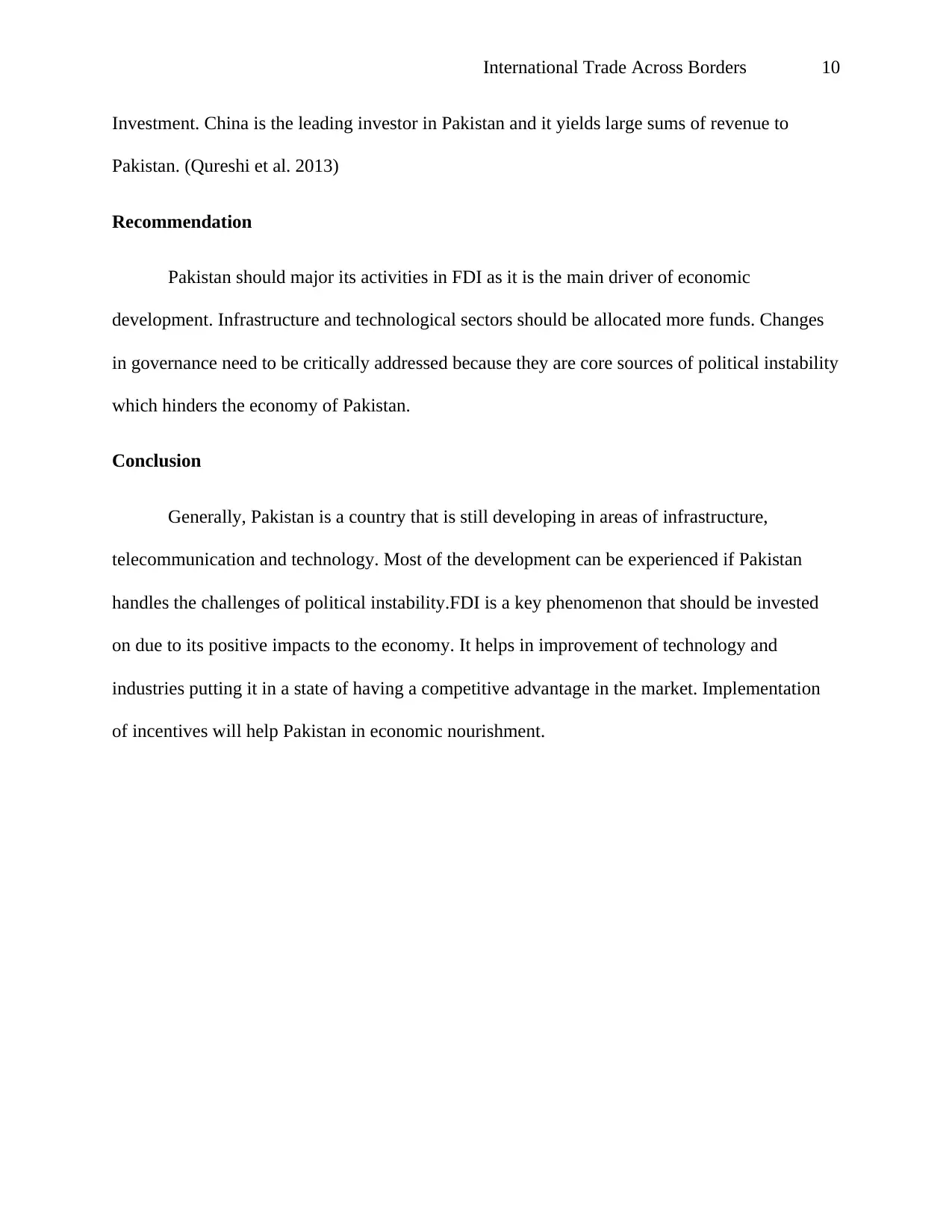
International Trade Across Borders 10
Investment. China is the leading investor in Pakistan and it yields large sums of revenue to
Pakistan. (Qureshi et al. 2013)
Recommendation
Pakistan should major its activities in FDI as it is the main driver of economic
development. Infrastructure and technological sectors should be allocated more funds. Changes
in governance need to be critically addressed because they are core sources of political instability
which hinders the economy of Pakistan.
Conclusion
Generally, Pakistan is a country that is still developing in areas of infrastructure,
telecommunication and technology. Most of the development can be experienced if Pakistan
handles the challenges of political instability.FDI is a key phenomenon that should be invested
on due to its positive impacts to the economy. It helps in improvement of technology and
industries putting it in a state of having a competitive advantage in the market. Implementation
of incentives will help Pakistan in economic nourishment.
Investment. China is the leading investor in Pakistan and it yields large sums of revenue to
Pakistan. (Qureshi et al. 2013)
Recommendation
Pakistan should major its activities in FDI as it is the main driver of economic
development. Infrastructure and technological sectors should be allocated more funds. Changes
in governance need to be critically addressed because they are core sources of political instability
which hinders the economy of Pakistan.
Conclusion
Generally, Pakistan is a country that is still developing in areas of infrastructure,
telecommunication and technology. Most of the development can be experienced if Pakistan
handles the challenges of political instability.FDI is a key phenomenon that should be invested
on due to its positive impacts to the economy. It helps in improvement of technology and
industries putting it in a state of having a competitive advantage in the market. Implementation
of incentives will help Pakistan in economic nourishment.
Paraphrase This Document
Need a fresh take? Get an instant paraphrase of this document with our AI Paraphraser
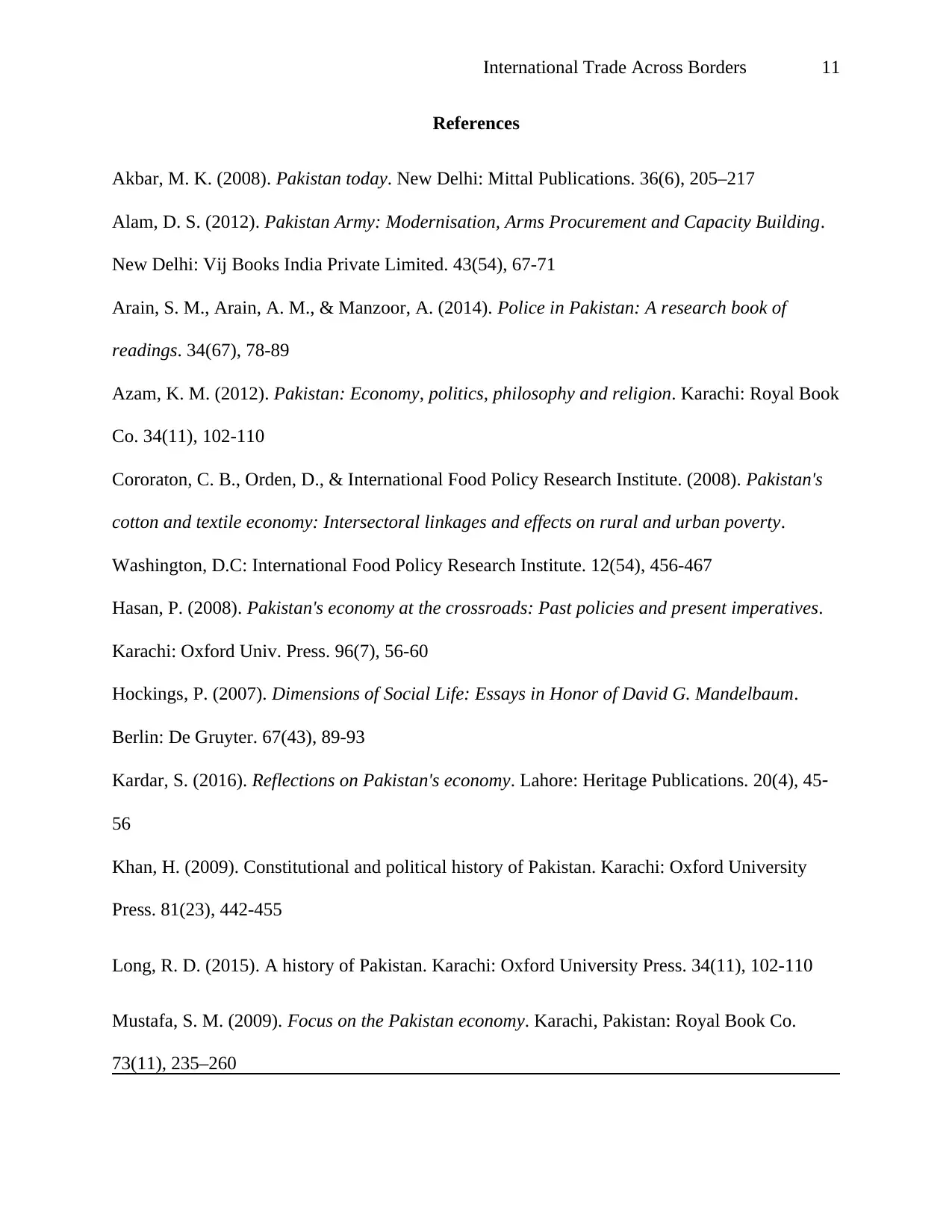
International Trade Across Borders 11
References
Akbar, M. K. (2008). Pakistan today. New Delhi: Mittal Publications. 36(6), 205–217
Alam, D. S. (2012). Pakistan Army: Modernisation, Arms Procurement and Capacity Building.
New Delhi: Vij Books India Private Limited. 43(54), 67-71
Arain, S. M., Arain, A. M., & Manzoor, A. (2014). Police in Pakistan: A research book of
readings. 34(67), 78-89
Azam, K. M. (2012). Pakistan: Economy, politics, philosophy and religion. Karachi: Royal Book
Co. 34(11), 102-110
Cororaton, C. B., Orden, D., & International Food Policy Research Institute. (2008). Pakistan's
cotton and textile economy: Intersectoral linkages and effects on rural and urban poverty.
Washington, D.C: International Food Policy Research Institute. 12(54), 456-467
Hasan, P. (2008). Pakistan's economy at the crossroads: Past policies and present imperatives.
Karachi: Oxford Univ. Press. 96(7), 56-60
Hockings, P. (2007). Dimensions of Social Life: Essays in Honor of David G. Mandelbaum.
Berlin: De Gruyter. 67(43), 89-93
Kardar, S. (2016). Reflections on Pakistan's economy. Lahore: Heritage Publications. 20(4), 45‐
56
Khan, H. (2009). Constitutional and political history of Pakistan. Karachi: Oxford University
Press. 81(23), 442-455
Long, R. D. (2015). A history of Pakistan. Karachi: Oxford University Press. 34(11), 102-110
Mustafa, S. M. (2009). Focus on the Pakistan economy. Karachi, Pakistan: Royal Book Co.
73(11), 235–260
References
Akbar, M. K. (2008). Pakistan today. New Delhi: Mittal Publications. 36(6), 205–217
Alam, D. S. (2012). Pakistan Army: Modernisation, Arms Procurement and Capacity Building.
New Delhi: Vij Books India Private Limited. 43(54), 67-71
Arain, S. M., Arain, A. M., & Manzoor, A. (2014). Police in Pakistan: A research book of
readings. 34(67), 78-89
Azam, K. M. (2012). Pakistan: Economy, politics, philosophy and religion. Karachi: Royal Book
Co. 34(11), 102-110
Cororaton, C. B., Orden, D., & International Food Policy Research Institute. (2008). Pakistan's
cotton and textile economy: Intersectoral linkages and effects on rural and urban poverty.
Washington, D.C: International Food Policy Research Institute. 12(54), 456-467
Hasan, P. (2008). Pakistan's economy at the crossroads: Past policies and present imperatives.
Karachi: Oxford Univ. Press. 96(7), 56-60
Hockings, P. (2007). Dimensions of Social Life: Essays in Honor of David G. Mandelbaum.
Berlin: De Gruyter. 67(43), 89-93
Kardar, S. (2016). Reflections on Pakistan's economy. Lahore: Heritage Publications. 20(4), 45‐
56
Khan, H. (2009). Constitutional and political history of Pakistan. Karachi: Oxford University
Press. 81(23), 442-455
Long, R. D. (2015). A history of Pakistan. Karachi: Oxford University Press. 34(11), 102-110
Mustafa, S. M. (2009). Focus on the Pakistan economy. Karachi, Pakistan: Royal Book Co.
73(11), 235–260
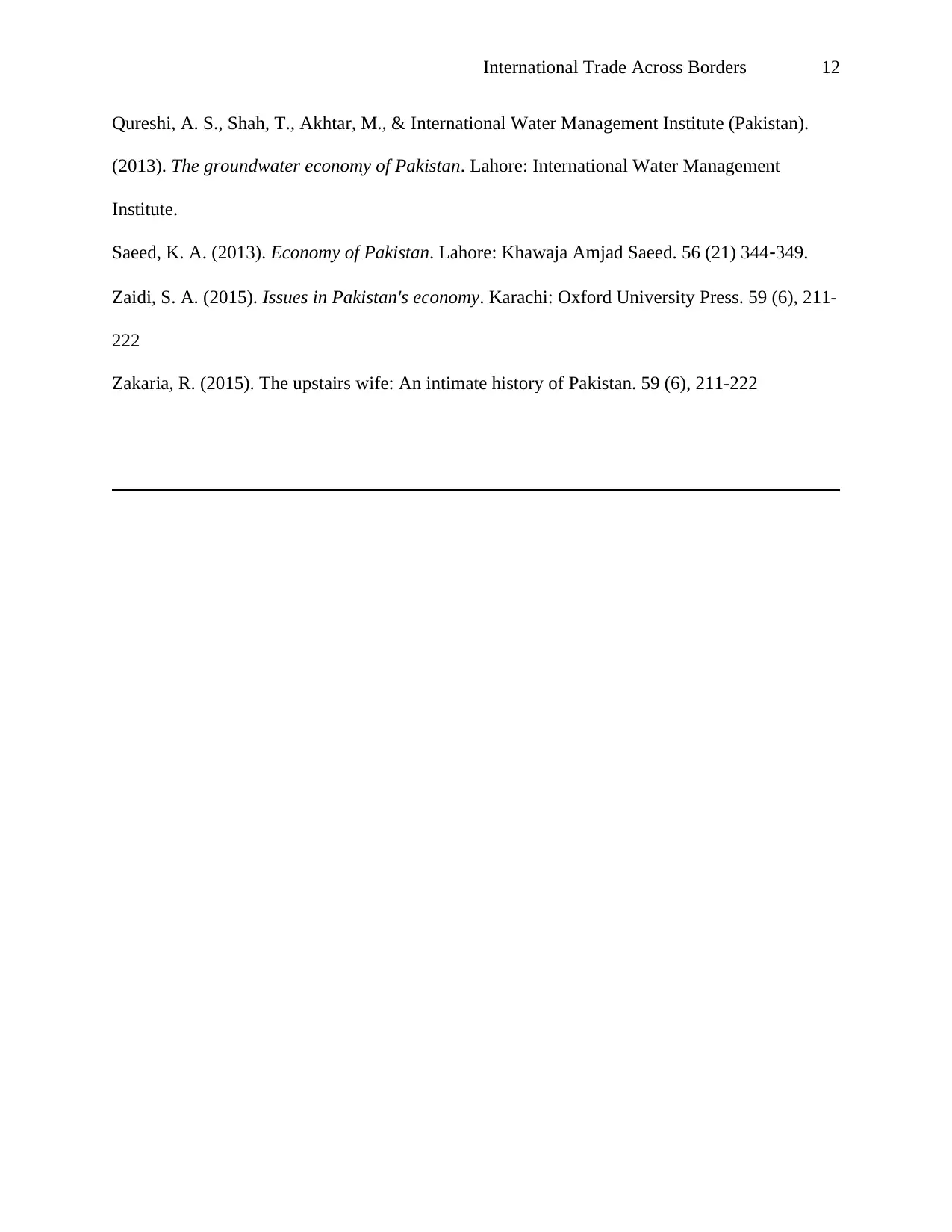
International Trade Across Borders 12
Qureshi, A. S., Shah, T., Akhtar, M., & International Water Management Institute (Pakistan).
(2013). The groundwater economy of Pakistan. Lahore: International Water Management
Institute.
Saeed, K. A. (2013). Economy of Pakistan. Lahore: Khawaja Amjad Saeed. 56 (21) 344‐349.
Zaidi, S. A. (2015). Issues in Pakistan's economy. Karachi: Oxford University Press. 59 (6), 211-
222
Zakaria, R. (2015). The upstairs wife: An intimate history of Pakistan. 59 (6), 211-222
Qureshi, A. S., Shah, T., Akhtar, M., & International Water Management Institute (Pakistan).
(2013). The groundwater economy of Pakistan. Lahore: International Water Management
Institute.
Saeed, K. A. (2013). Economy of Pakistan. Lahore: Khawaja Amjad Saeed. 56 (21) 344‐349.
Zaidi, S. A. (2015). Issues in Pakistan's economy. Karachi: Oxford University Press. 59 (6), 211-
222
Zakaria, R. (2015). The upstairs wife: An intimate history of Pakistan. 59 (6), 211-222
⊘ This is a preview!⊘
Do you want full access?
Subscribe today to unlock all pages.

Trusted by 1+ million students worldwide
1 out of 12
Related Documents
Your All-in-One AI-Powered Toolkit for Academic Success.
+13062052269
info@desklib.com
Available 24*7 on WhatsApp / Email
![[object Object]](/_next/static/media/star-bottom.7253800d.svg)
Unlock your academic potential
Copyright © 2020–2025 A2Z Services. All Rights Reserved. Developed and managed by ZUCOL.





